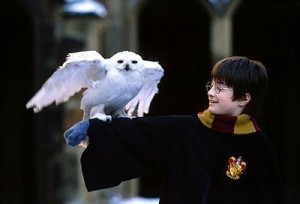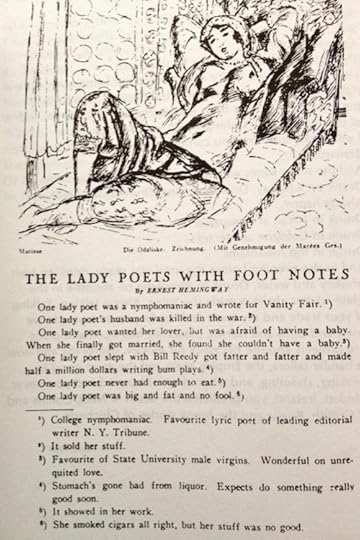The Paris Review's Blog, page 913
May 24, 2012
Reconstructing Harry Crews
Still from The Rough South of Harry Crews.
I was making a film about a local author when I met Harry Crews. He was not my subject; he was my subject’s inspiration. “You oughta put a camera on this guy,” the local author urged. “Get him while you can.” “While you can” meant “while he’s sober.” Evidently Crews had been especially lucid lately, not drinking and willing to talk. So we set up a day, loaded our cameras and drove nine hours south from Chapel Hill, North Carolina, to a gridded section of suburban Gainesville. When I knocked on his door, he yanked it open, eyes wide, like I’d caught him in the middle of some desperate act.
“You Hawkins?”
“Yes.”
He threw his arms out like a flagman on an aircraft carrier.
Read More »The Thief’s Journal
 Some days, after eighth grade at Emerson Junior High, I would walk to the 7-11 on Overland, in the shadows of the monumental Mormon temple on Santa Monica Boulevard, and just loiter there. I never bought anything, but walked up and down the rows staring intensely at Corn Nuts, Big League Chew, and sundry sparkling sugar bombs.
Some days, after eighth grade at Emerson Junior High, I would walk to the 7-11 on Overland, in the shadows of the monumental Mormon temple on Santa Monica Boulevard, and just loiter there. I never bought anything, but walked up and down the rows staring intensely at Corn Nuts, Big League Chew, and sundry sparkling sugar bombs.
I didn’t then, nor do I now, have anything resembling a sweet tooth. I’ll trade dessert and candy for savory treats every time (I loved Funyuns, whatever they were), and yet, I wanted a snack. I didn’t have any money, of course—I was twelve—but it wasn’t as if I were starving to death. At the time of my choosing I could walk to my father’s apartment nearby, where he would make me green-chile chicken with polenta, or leg of lamb and gratin dauphinois, or maybe even steak and mashed potatoes. But my dad doesn’t do snacks. He might have food for the entire week, but when I open the fridge, there’s nothing there.
The bus would take a good forty-five minutes to my mom’s, where the fridge was full of Clausen pickles, deli meats, and cheese for my beloved Triscuits. I could have skated if I’d have brought my board, but, forty-five dolorous, head-pounding minutes of boredom and discomfort, sitting next to cat ladies and gangbangers on the rough, tough, and dangerous bus … I wanted a snack. I needed a treat.
Siegfried and Roy: Masters of the Kitchen
 The one chance I had to see Siegfried and Roy perform live, in May 2003, I was too broke to go. A friend was getting married in Las Vegas, and all of us were staying four to a room at the (now demolished) Stardust because it was the cheapest option on the Strip. (My salary from the anarchist bakery where I was working at the time didn’t allow for much extravagance.)
The one chance I had to see Siegfried and Roy perform live, in May 2003, I was too broke to go. A friend was getting married in Las Vegas, and all of us were staying four to a room at the (now demolished) Stardust because it was the cheapest option on the Strip. (My salary from the anarchist bakery where I was working at the time didn’t allow for much extravagance.)
At some point during the wedding weekend, we ended up at the Mirage, home to Siegfried and Roy’s signature white-tigers-and-smoke-machines show. I clearly remember looking at the enclosure where the tigers lived, but strangely, I can’t remember whether we actually saw any of them. We did visit the gift shop, where someone picked up a copy of Siegfried und Roy: Meister der Illusion, an astonishing book, made all the more enjoyable because I couldn’t understand a word of the text. Read More »
Great Gatsby, Great Casting, Commas
Dubious.
Electric Literature’s Required Reading kicks off with a Ben Marcus story and accompanying animation.
Your new favorite time waster: I Shot the Serif.
Zach Galifianakis is Ignatius J. Reilly.
Most comma mistakes.
Zelda draws Scott.
Speaking of, the first glimpse of Baz Luhrmann’s Great Gatsby trailer elicits … strong emotions.
May 23, 2012
Dear Joan Holloway, the Sixties Will Pass
Dear Joan Holloway,
First off, a thank you. Thank you for reminding me why I still tune in. Things were iffy for a while, what with Don’s extramarital dalliances confined to the boudoirs of his fever dreams, Betty in a budget fat suit, and Campbell and Price going all Fight Club on us.
But last night you were back, barely contained by a skin-tight scoop neck that left no curve concealed. You were back and in top form, trotting out instaclassic lines, like “My mother raised me to be admired,” in your signature, sultry deadpan. You were back, and what I’m saying is, Joanie, without you there is no Mad Men; there are men and they are mad, but you add the uppercase.
Arthur Miller Reads Death of a Salesman, February 1955
From the 92nd Street Y Poetry Center’s archives.
Finding Francesca Woodman
Francesca Woodman, Caryatid, 1980, diazotype, 7' 5 in. x 3'. Courtesy George and Betty Woodman © 2012 George and Betty Woodman
We’re fascinated by artists who die young. Something about the unnaturalness of an early death gives us a kind of morbid thrill. We hail their genius, attracted by the mystery of the unknown (and unknowable). Maybe we’re envious—at least, the parts of us that seek fame and approval. For the dead, everything is fixed and frozen; there’s no more work and no more pressure to perform. Pore as we will over their output, what they’ve left behind in the world will never change.
Francesca Woodman was an artist who died young. She committed suicide, jumping from a window when she was twenty-two. I was thinking of waiting to tell you that, of trying to withhold the information until later in this essay, but the effort seemed futile: if you’re in art school, or read the New York Times, or have looked at the Guggenheim’s Web site lately, or even if you get the Skint, a daily New York events e-mail, you already know.
The Skint mention is particularly curious. Somehow, in a newsletter composed of brief, one-line descriptions of featured events, Woodman’s suicide merited inclusion: “Thru 6/13: 120 works of photographer francesca woodman (nsfw), who committed suicide at age 22 in 1981, go on display at the Guggenheim.” The implication seems to be that her suicide either makes her more interesting or more worthy of an exhibition.
Owls, Hatred, and Blurbese
Bad for owls
The lit-flick streak continues! The Palme d’Or is likely to go to one of several adaptations.
As Harry Potter mania fades, hundreds of pet owls are being abandoned across England.
How to open a new book.
Quiche Lorraine, the comic.
Need inspiration? Dial-a-poem!
Andrew Ladd decodes Blurbese for the nonreviewer.
When less is more: minimalist covers.
Cineastes! Help save an endangered film before it’s too late!
William Hazlitt, "On the Pleasure of Hating."
May 22, 2012
Hemingway on “The Lady Poets”
Thanks to Tongue Journal and the Poetry Foundation for bringing us this fantastic bit of annotation! In November 1924, Ernest Hemingway published “The Lady Poets with Foot Notes” in Der Querschnitt. It's a satirical poem full of lit-world in-jokes and allusions to female poets of the day, and Hemingway scholar Michael Reynolds has IDs them. The poetesses are:
1. Edna St. Vincent Millay
2. Aline Kilmer
3. Sara Teasdale
4. Zoe Akins
5. Lola Ridge
6. Amy Lowell
The Poetry Foundation has more to say about all of them!
Among the Automata
 By now, the entire Internet is aware that last month A/V technicians at Coachella resurrected Tupac for a performance with Snoop Dog and Dr. Dre. Though a little phosphorescent, the rapper seems lifelike enough in the videos, with his Timberlands and rather nice abs. Cumulatively, though, the effect, especially when (living) Snoop is in the frame, is, above all else, weird. Watching the virtual Pac unintentionally moonwalk across the stage, we might think of E.T.A. Hoffmann’s “Sandman”: “Aha! Pretty doll! Spin round, lovely doll!” Not as odd a juxtaposition as it may seem: as Gizmodo reports, the effect was produced by means of a nineteenth-century trick called “Pepper’s Ghost.”
By now, the entire Internet is aware that last month A/V technicians at Coachella resurrected Tupac for a performance with Snoop Dog and Dr. Dre. Though a little phosphorescent, the rapper seems lifelike enough in the videos, with his Timberlands and rather nice abs. Cumulatively, though, the effect, especially when (living) Snoop is in the frame, is, above all else, weird. Watching the virtual Pac unintentionally moonwalk across the stage, we might think of E.T.A. Hoffmann’s “Sandman”: “Aha! Pretty doll! Spin round, lovely doll!” Not as odd a juxtaposition as it may seem: as Gizmodo reports, the effect was produced by means of a nineteenth-century trick called “Pepper’s Ghost.”
 The nineteenth century represents the tail end of humanity's fascination with the mechanical replication of itself. Much effort had been expended in that direction the century prior, in the Marais neighborhood of Paris, where the automata builders lived and worked. That the word automata comes from an economical Greek verb for “acting of one’s own will” points somewhat toward the source of the period’s fascination with them; miming organic processes, these machines seemed to be animated by something beyond gears and wires. Actually, they were operated by clockwork: linkages or rods in the body connected to a set of cams, irregular wheels concealed in the object’s base or body. The cams served as the object’s “memory” and turned in a circular motion—a winding key, for instance—into linear, transposing mechanics into something resembling life. Automata were, as Freud put it, in his essay on the uncanny, unlike us enough to be at once familiar and strange, or at least “secretly familiar.” It was uncertain whether they were really doing what they appeared to be, whether they lived, whether they had something resembling a soul. But like Tupac, automata were reproducible, replaceable, and performed the same actions again and again. There were also many copies, quite a few of which still survive.
The nineteenth century represents the tail end of humanity's fascination with the mechanical replication of itself. Much effort had been expended in that direction the century prior, in the Marais neighborhood of Paris, where the automata builders lived and worked. That the word automata comes from an economical Greek verb for “acting of one’s own will” points somewhat toward the source of the period’s fascination with them; miming organic processes, these machines seemed to be animated by something beyond gears and wires. Actually, they were operated by clockwork: linkages or rods in the body connected to a set of cams, irregular wheels concealed in the object’s base or body. The cams served as the object’s “memory” and turned in a circular motion—a winding key, for instance—into linear, transposing mechanics into something resembling life. Automata were, as Freud put it, in his essay on the uncanny, unlike us enough to be at once familiar and strange, or at least “secretly familiar.” It was uncertain whether they were really doing what they appeared to be, whether they lived, whether they had something resembling a soul. But like Tupac, automata were reproducible, replaceable, and performed the same actions again and again. There were also many copies, quite a few of which still survive.
The Paris Review's Blog
- The Paris Review's profile
- 305 followers









